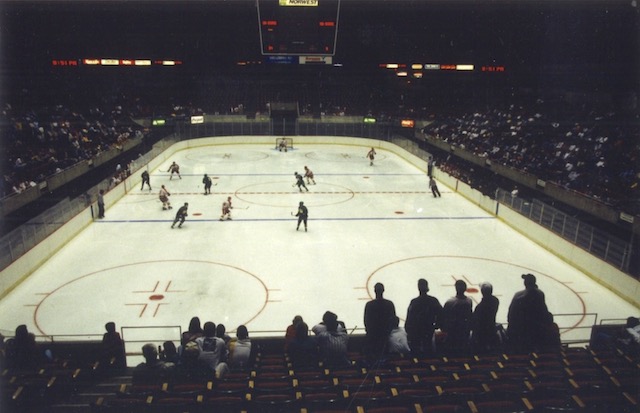
From the early 1970s into the 1990s, hockey was played – at least occasionally – inside Hilton Coliseum. Photo by Bernie English
March/April 2023 (Volume 15, Issue 2)
By Tim Harwood
Chris Murray came to Iowa State University to coach track, not hockey.
Al Murdoch happened to bring along his stick and skates when he moved to Ames for graduate school.
Graeme Doyle aspired to play basketball after his family relocated to central Iowa.
Murray, Murdoch and Doyle were all born in Canada.
Dave Lee was from the small Iowa town of Rake, but hockey had legitimately been right in Lee’s backyard for his entire life.
The origin of Iowa State University hockey in the 1960s was similar to the beginnings for football and basketball teams on college campuses across the country at the turn of the 20th century. With a shared enthusiasm plus time between classes, students from varying backgrounds came together organically. Their experience and ability may not have been well-matched, but none of ISU’s first hockey players expected to reach the National Hockey League nor even earn an athletic scholarship. They were looking to fill the time and for a way to fit in. In the six decades that followed, hockey became an important part of Iowa State student life for hundreds of players and thousands of fans.
“It was initially just pickup games on an outdoor rink at Brookside Park,” said Murray. “I just got wind that people were playing pickup hockey and went over. Then because they learned I was connected with the athletic department, they started talking to me about getting a little more organized.”
Murray had grown up playing hockey on outdoor ice. In more formal competition, he was a goalie until being jarred by a slap shot to the head. The incident made his parents second-guess his choice of position, which, at that time, did not yet include a face mask with the rest of the gear.
Track shoes were the only equipment required for Murray’s best sport. He was a Big Ten champion middle distance runner at the University of Michigan and went to the 1964 Olympics for Canada in the steeplechase.
“I was just finishing my masters at the University of Illinois and saw a job at Iowa State as an assistant track and field/cross country coach,” Murray said. “That was actually my first full time job.”
Between cross country in the fall, track in the spring, and responsibilities in the PE department year-round, Murray spent winter Sundays on skates. His group was soon recognized by ISU student government as a campus club in 1965. That status gave them access to financial support for uniforms and equipment.
Meanwhile, teenaged Graeme Doyle was busy organizing his own hockey project. Doyle’s family was one of hundreds which had moved from the Toronto area to Des Moines as farm machinery manufacturer Massey Ferguson relocated its headquarters in 1965. After years of following the Boston Celtics on radio, Doyle believed the new surroundings finally offered his chance to play basketball at a high level.
He had every expectation of making the defending state champion Des Moines Roosevelt High School basketball squad.
At five-feet, eight-inches.
As a center.
Roosevelt basketball coach Al Comito gently pointed out the improbability of those aspirations.
“He said, ‘Is there another sport that you play?’ and I said, ‘Well, I used to play hockey,’” Doyle remembered, “So he said, ‘Here’s what we’ll do: you spend four days a week starting high school hockey, and each Friday, you come and tell me what you’ve accomplished during the week, and I’ll base your grade on that, rather than on gym class.’”
After persuading Massey Ferguson executives to contribute money to insure the sport, Doyle says the first high school game in the city was between Roosevelt and Dowling Catholic High School in early 1967. By the next year, there were four teams playing a winter schedule against one another at the Des Moines Ice Arena on Hickman Road and 72nd Street. Doyle had the chance to play two full seasons with his classmates before graduating in 1969.
“After my last high school hockey game, this guy who was coaching the Iowa State hockey team [Murray] asked me to come up and take a look at their program,” said Doyle, whose parents were encouraging him to look for an in-state college. “There were a couple of guys ahead of me in high school that had gone up to Iowa State, and one of them was on the team, so that was how I got to Iowa State.”
TO READ THE ENTIRE STORY AND OTHER FASCINATING STORIES ABOUT IOWA HISTORY, subscribe to Iowa History Journal.
